Different Types Of Sharks, Orders, and Species
Sharks are fantastic, fierce creatures that have a reputation for hunting as natural predators in the oceans. Today, we have over 500 different types of shark species in 8 different orders living in just about every ocean worldwide with varying lengths and sizes.
Sharks have a muscular streamlined frame that allows them to swim fast in search of prey. They also have a strong sense of smell and other senses that help them detect their next meal.
This article will dive into the shark world to explore the different types of sharks.
Keen to read up more on these fascinating animals, our shark quotes explore what people have to say about them, from history through legend and famous films. While our ocean facts and whale facts cover their watery home and the largest mammals they share it with.
How long have sharks existed?
It will interest you to know that these creatures have been around longer than dinosaurs. The first sharks evolved over 400 million years ago7.
Unlike dinosaurs, mammals, and reptiles, a shark is a cartilaginous fish, like rays and skates, and does not leave behind bone fossils. However, shark teeth, skin scales, vertebrae, and shark tissues give us some clues to how sharks evolved from then until now.
The oldest shark tooth found dates back as far back as 400 million years from the Devonian period.
The 8 groups of sharks
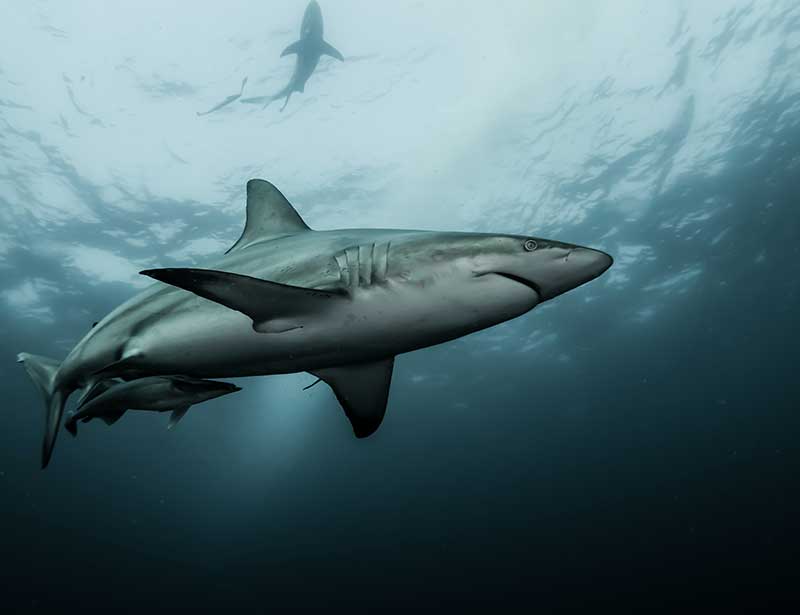
Different types of sharks fall under eight orders or groups. Here are the eight groups of sharks:
1. Ground sharks
Most sharks belong to the Ground Shark or Carcharhiniformes order. Being the largest order of sharks, it consists of over 270 shark species. Groud shark species exist in almost every marine ecosystem in the world.
We can characterize ground sharks by their five gills slits, an anal fin, nictitating eyelids, and two spineless dorsal fins. They also have wide mouths with sharp teeth. Ground sharks may range from a length of 45cm to 6m.
Examples of ground shark species include hammerhead sharks, the oceanic whitetip shark, catsharks, tiger sharks, weasel sharks, and so on. Ground sharks also comprise the requiem shark family, including species like the gray reef shark.
2. Bull sharks
Bull sharks or horn sharks, also known as Heterodontiformes, are a small order of sharks that we can find in tropical or temperate coastal waters. The bull shark has five pairs of gills slits that you can see above their pectoral fins, an anal fin, and a mouth that consists of sharp and round flat teeth. They also have a unique spiral skin pattern.
Some bull shark examples include zebra bullhead sharks and horn sharks.
3. Cow and frilled sharks
The cow and frilled shark, also known as Hexanchiformes, are the smallest order of sharks, consisting of just seven species. They are also the most primitive order, which evolved around 150 million years ago. This kind of shark's physical features includes a single dorsal fin, seven pairs of gills slits, an anal fin, and thorny teeth. Some cow and frilled shark species include cow sharks and frilled sharks.
4. Mackerel sharks
Mackerel sharks, also known as Lamniformes, consist of the most common shark species people often think of. This includes the Great White sharks, thresher sharks, sand sharks, and basking sharks who don’t hunt prey. We can characterize the Mackerel Shark by a large mouth with multiple rows of sharp teeth, two dorsal fins, an anal fin, and five gills slits.
5. Carpet sharks
Carpet sharks or Orectolobiformes consist of a diverse range of shark species, including the largest shark - the Whale shark.
Carpet sharks are mostly found in Indian Oceans and Pacific Oceans. They have five gills slits, two dorsal fins, one anal fin, spiracles around the eyes, and patterned skin. Other examples of carpet sharks include the zebra shark and Bamboo shark.
6. Saw sharks
Saw sharks or Carpenter sharks, also known as Pristiophoriformes, consist of eight shark species. What makes these sharks unique is their snouts which look like long saws. They use this to defend themselves against predators. These sharks are characterized by five or six gills slits, wide pectoral fins, two dorsal fins, no anal fin, and transverse teeth.
You can find saw sharks ranging from 5 feet to 25 feet long. Examples include the Bahamas saw shark and the Knifetooth saw shark.
7. Angel shark
Angel sharks or Squatiniformes can be found in temperate and tropical waters close to coastal lines. Sadly, these sharks are among the endangered sharks on our planet and are often caught by fishing nets. The Angel shark is characterized by a flat body, angular pectoral and pelvic fins, no anal fin, dermal flaps, and eyes on top of their head. Some examples of the Angel shark include the Angel shark, Sand Devil, and the Philippines Angelshark.
8. Dogfish shark
From Greenland sharks to the Cookiecutter shark and lantern sharks, the Dogfish shark order is one of the most diverse orders of sharks. It also consists of the smallest shark in the world- the Dwarf Lantern shark. It also consists of the Ninja Lantern shark, discovered by researchers in 2015, which glows in the dark.
Dogfish sharks have two dorsal fins, five gills slits, no anal fin, a short mouth, and a long snout.
20 types of sharks you should know
Here’s a list of 20 different fascinating types of shark species from all over the world.
1. Blacktip reef shark
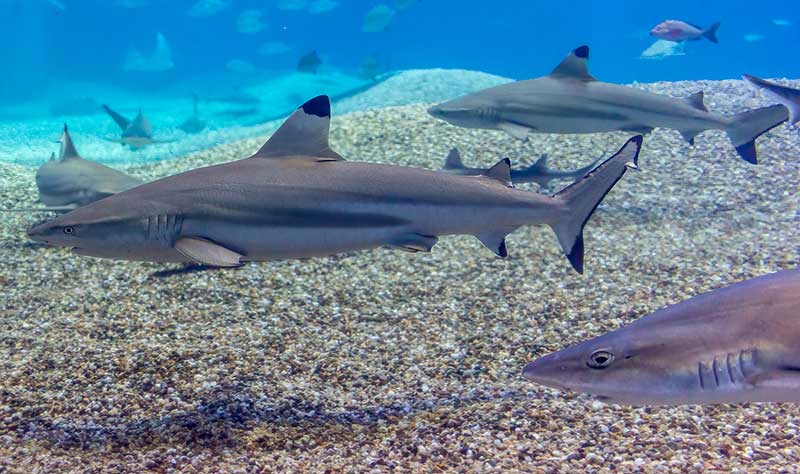
Scientific name: Carcharhinus melanopterus
Type of shark: requiem shark
Group/Order: Carcharhiniformes
The Blacktip reef shark (different from the blacktip shark) is a requiem shark that you can find in the tropical and subtropical waters of the central pacific and Indian oceans. Blacktip reef sharks live around coral reefs and shallow coastal waters. These types of sharks are moderate in size and come in a brownish-grey color, rounded stout, and have a white and black tip on the first dorsal fin and caudal fin.
The Blacktip reef shark is at the top of the food chain and preys on small fish like mullet and groupers as well as invertebrates like shrimps and octopus.
These sharks typically swim in calf-deep water with their black tips breaking the water's surface. Blacktip reef sharks could get aggressive around competing sharks and may rush wounded baits or fish.
2. Tiger shark

Scientific name: Galeocerdo Cuvier
Type of shark: requiem shark
Group/Order: Carcharhiniformes
The Tiger shark has earned quite the reputation as a man-eater - being second only to the Great whites in attacking humans.
Asides from its infamous reputation, the Tiger shark is a requiem shark, typically found in tropical and temperate oceans, mostly on reefs and shelves.
They earn their name “Tiger shark” from the back tiger-like stripes on their juveniles. As the Tiger shark matures, these stripes fade and eventually disappear. They have an excellent sense of smell and sight, with powerful jaws and teeth that help them capture and feed on their prey.
Their prey includes anything from sea turtles to sea snakes, seals, birds, squids, and even objects like old tires (which don’t provide nutritional value and are harmful when eaten).
The Tiger shark can weigh as much as over 1900 pounds and grow as long as 20 to 25 feet5.
Sadly, humans heavily harvest the Tiger shark for the processing of vitamin oil, and it is now a near-threatened species.
3. Shortfin mako shark
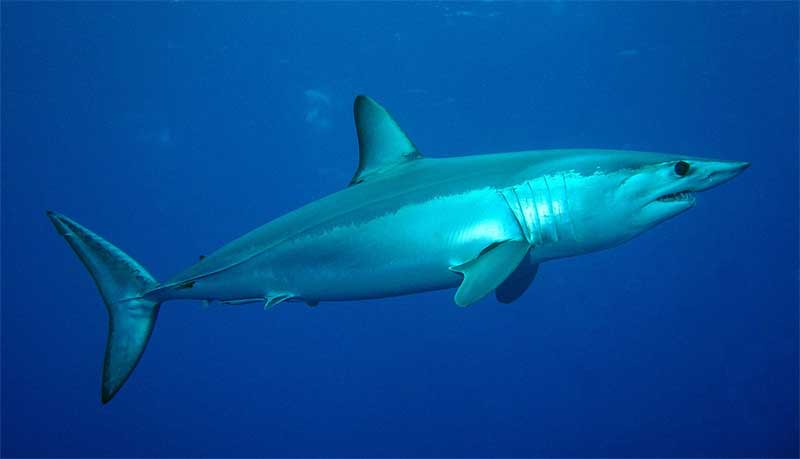
Scientific name: Isurus oxyrinchus
Type of shark: Mackerel shark
Group/Order: Lamniformes
Shortfin mako sharks are large predatory sharks that live out in open oceans. They have streamlined body and crescent-shaped tail that helps them swim very fast.
The Shortfin mako shark is the fastest shark and one of the fastest fish in the world. They have great leaping ability and can leap out of the water to significant heights while hunting.
They are also migratory creatures and can make long migrations every year.
The Shortfin mako shark, just like the Great whites, has a particular blood vessel structure called the countercurrent exchanger. This structure helps them maintain a higher body temperature than their surrounding water.
The Shortfin mako shark is an apex predator and can feed on a wide range of prey, including other sharks, sea turtles, and small marine mammals.
4. Whale shark

Scientific name: Rhincodon typus
Type of shark: carpet shark
Group/Order: Orectolobiformes
Whale sharks are the largest fish in the world, with a length of 40 feet and more!
The whale sharks' habitat is in tropical and warm waters all over the world apart from the Mediterranean sea. They are also known to migrate to the continental shelf of the central west coast of Australia every spring. The whale shark has a flattened head and blunt snout above its mouth4. The two dorsal fins go backward on its body and end with a caudal lobbed tail.
The whale shark is a filter feeder and feeds on plankton. These creatures scoop plankton, tiny as well as tiny plants and animals, as they swim through to the water's surface.
5. Basking shark

Scientific name: Cetorhinus Maximus
Type of shark: Mackerel shark
Group/Order: Lamniformes
Basking sharks are the second-largest shark type and the world's second-largest fish. It has a conspicuous gaping mouth with six rows of teeth on the upper jaw and nine rows on the lower jaw. Its entire mouth falls with a total of around 1500 tiny teeth.
While the basking shark may look harmful, these creatures are harmless. Like the whale shark, these creatures are also filter feeders and filter zooplanktons with their special organs called gill rakers.
Moving at two miles per hour, the basking shark can filter around 2000 tons of seawater2.
These creatures can be found in the coastal waters in tropical and temperate waters all over the world. They are also highly migratory and can travel to coastal waters in the spring and summer.
Sadly, the basking shark is highly targeted for skin and meat, causing its population to decline drastically. Today, the basking shark is an endangered species.
6. Blue shark
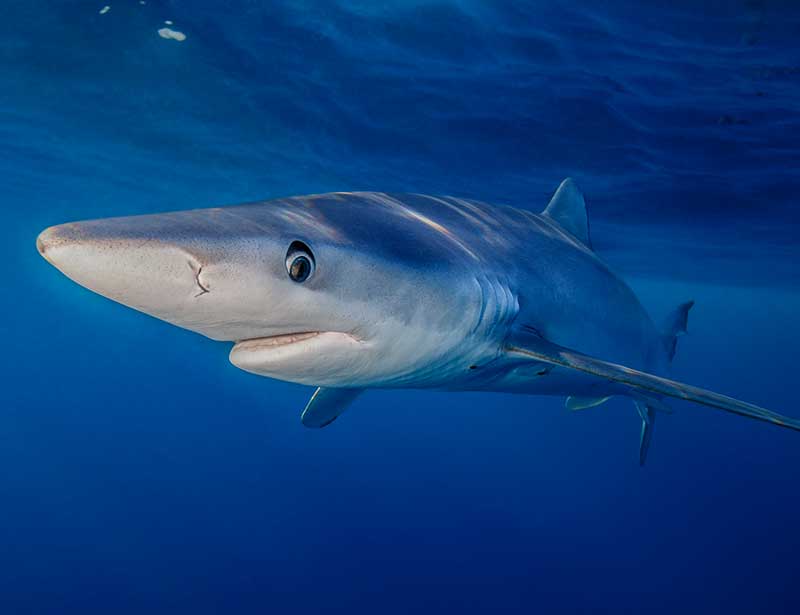
Scientific name: Prionace glauca
Type of shark: requiem shark
Group/Order: Carcharhiniformes
The Blue shark or great blue shark is noted for its distinctive deep blue color and white belly. It has a pointed snout, saw-edged teeth, and slim pectoral fins. The blue shark can grow as long as 8.2 feet or even 12 feet3.
During courtship and mating, the male blue shark bites the female blue shark. Over time, female blue sharks have evolved with thicker skin than males.
Blue sharks can be found in temperate and tropical areas all over the world. They prey on fishes(like hake), squids, seabirds, and sometimes carcasses of dead whales. They are typically not aggressive. However, they can be potentially dangerous to humans.
7. Great White shark
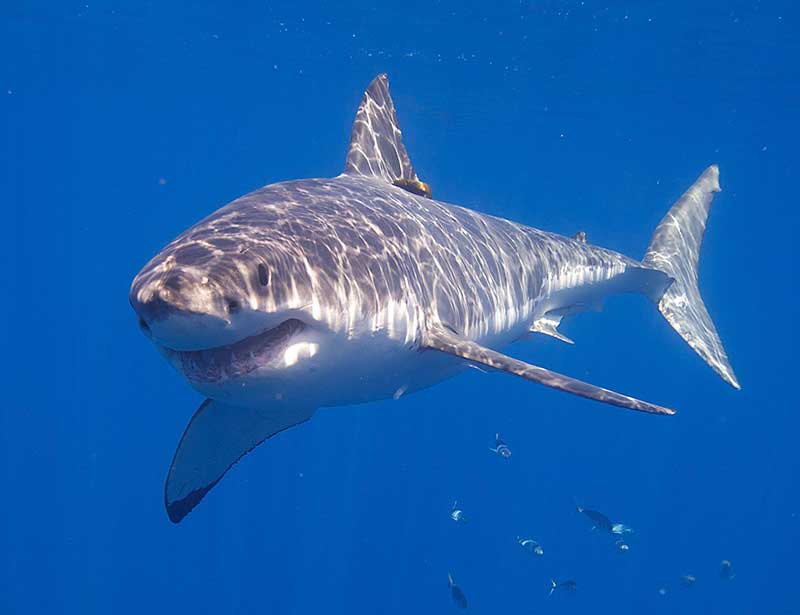
Scientific name: Carcharodon carcharias
Type of shark: mackerel shark
Group/Order: Lamniformes
The Great white shark is among the most popular among other shark species. Unfortunately, the Great Whites earn their reputation from being responsible for the most human attacks of all the shark species.
The Great White sharks are found in coastal waters and are the largest predatory fish6, growing as long as 18ft or even 20ft. They are cartilaginous, which means they have cartilage for a skeleton as opposed to bones. They can be found in temperate and tropical waters and have a streamlined swimming pattern with strong tails that propel them at up to 15 miles per hour.
Their mouth is lined with up to 300 serrated teeth in several rows. They also have a powerful sense of smell that helps them detect prey, including crustaceans, mollusks, and other sharks.
In reality, most Great White shark attacks are not fatal. Research has shown that humans are not on the Great White’s menu. Due to overfishing, Great White sharks are classified as vulnerable.
8. Great Hammerhead shark
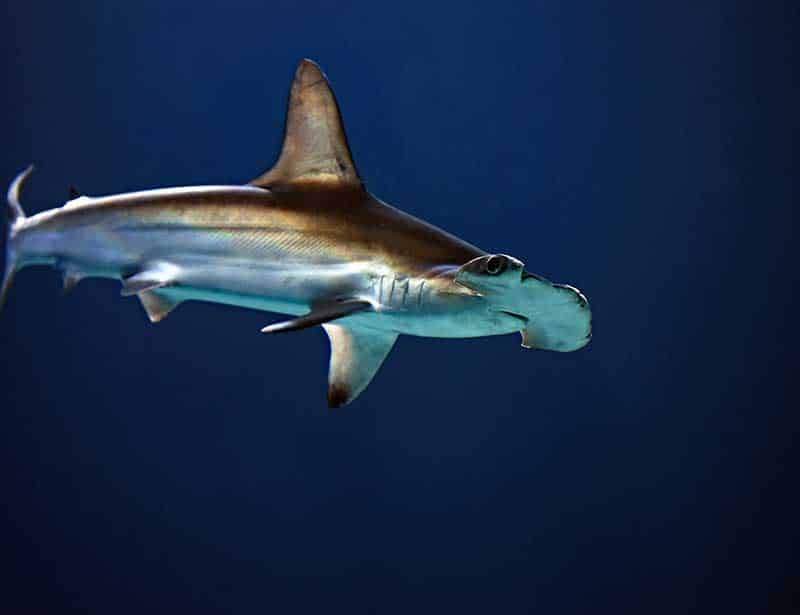
Scientific name: Sphyrna mokarran
Type of shark: hammerhead shark
Group/Order: Carcharhiniformes
Great Hammerhead sharks are the largest of the Hammerhead species and can grow as large as 20 feet.
The Great hammerhead shark is noted for its straight hammerhead-shaped head known as cephalofoil1. The cephalofoil provides improved vision which helps the shark see above and below it. The Great hammerhead can be found all over the world in warm coastal waters living in coral reefs.
Unfortunately, these types of sharks are a high target for commercial fisheries, causing their population to decline. Its current conservation status falls under the critically endangered species.
9. Nurse shark
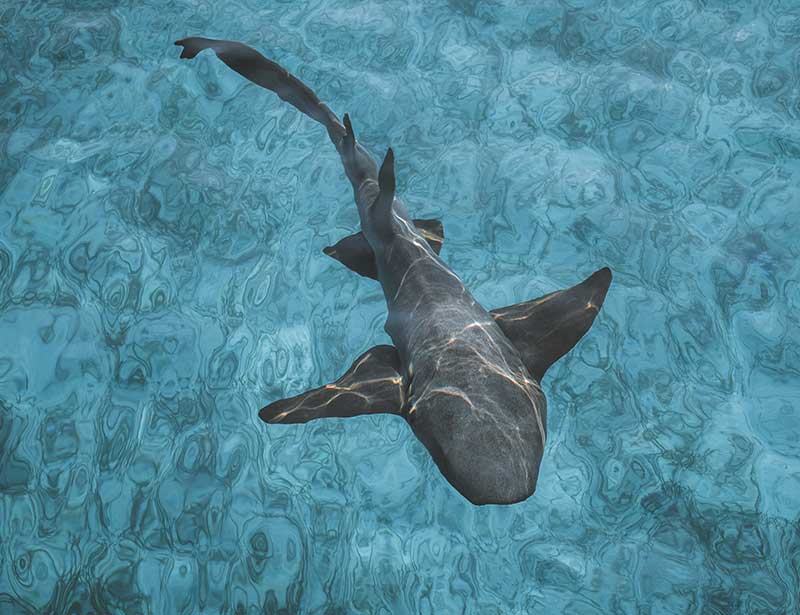
Scientific name: Ginglymostoma cirratum
Type of shark: carpet shark
Group/order: Orectolobiformes
Nurse sharks can be found in the shallow waters of the eastern Pacific and western Atlantic oceans. They are slow swimmers and mostly stay at the bottom of the sea. The nurse shark has a grey-brown color and is as long as 10 feet.
Nurse sharks have barbels located close to the nostrils over the mouth. They also have strong jaws with thousands of tiny teeth, which they use to crush and eat their prey. They also have a long tail fin which is around one-fourth of their entire body length.
If threatened in their docile state, the nurse shark can bite. Nurse sharks are responsible for numerous documented attacks on humans.
10. Goblin shark

Scientific name: Mitsukurina owstoni
Type of shark: Mackerel shark
Group/Order: Lamniformes
Goblin sharks are one of the most bizarre-looking types of sharks. These creatures have an elongated jaw and nose that protrudes out of their mouth. We can find these rare Goblin sharks deep in the Indian, Atlantic, and Pacific oceans, and they can be as long as 13 to 20 feet. These sharks are carnivores and feed on Teleost fish, cephalopods, and crustaceans.
11. Whitetip reef shark

Scientific name: Triaenodon obesus
Type of shark: requiem shark
Group/Order: Carcharhiniformes
Whitetip reef sharks get their name from their white dorsal and tail fins. This species are typically around 5 feet in length. They can be found around the Indo-pacific oceans living in reefs.
Whitetip reef sharks are nocturnal and spend their day resting on the ocean floor or in their caves in groups lying down parallel or on top of one another. These creatures are active hunters at night, feeding on octopuses, fish, and crustaceans.
12. Caribbean reef shark
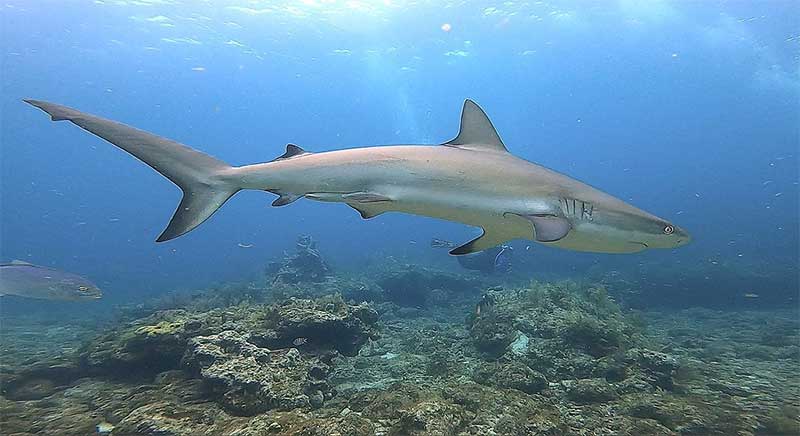
Scientific name: Carcharhinus perezi
Type of shark: requiem shark
Group/Order: Carcharhinidae
The Caribbean reef shark is one of the largest predators within the reef ecosystem, measuring 9.8 feet long. These sharks feed on various fish, including tropical fish, crabs, and shrimps. The Caribbean reef shark mainly rests motionless on the ocean floor and enjoys swimming around the shallow waters. These sharks are generally not aggressive. However, they could bite if threatened.
13. Sand Tiger Shark
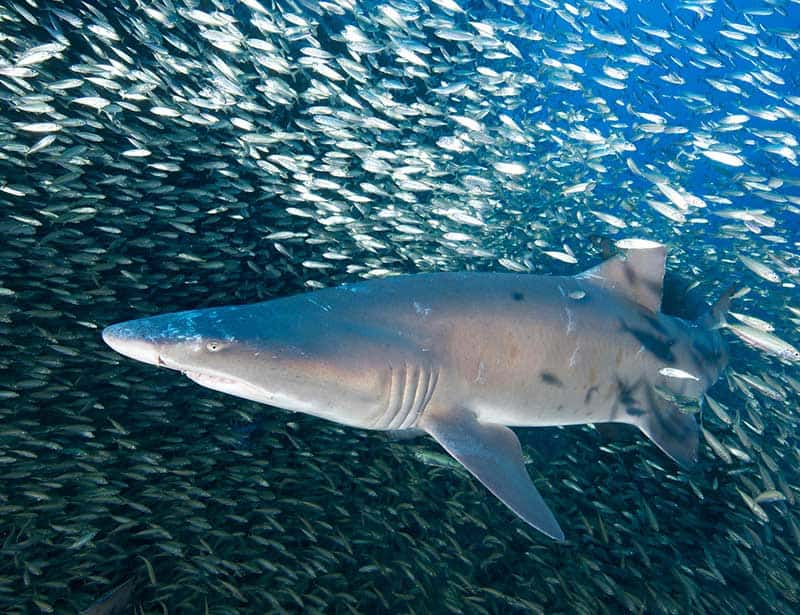
Scientific name: Carcharias taurus
Type of shark: sand shark
Group/Order: Lamniformes
Found in subtropical and temperate regions, the sand tiger shark is a member of the sand shark family and can be characterized by its pointed snout.
Sand Tiger sharks are typically around 8.5 feet and can go as far as 10.5 feet in length. These sharks swim with an open mouth and visible pointed teeth. Despite its visible teeth and ferocious look, sand tiger sharks are not aggressive and rarely attack humans except when provoked.
Sadly sand tiger sharks are a high target for commercial fisheries causing a declining population. Today, sand tiger sharks are critically endangered sharks.
14. Pacific sleeper shark

Scientific name: Somniosus pacificus
Type of shark: dogfish shark
Group/Order: Squaliformes
The pacific sleeper shark belongs to the dogfish family and is characterized by a heavy cylindrical body, two dorsal fins, and no anal fin. It has a rounded snout, blade-like lower teeth, and lance-shaped upper teeth.
Pacific sleeper sharks typically reach a maximum length of at least 20 feet. These sharks inhabit the North pacific ocean and feed on a variety of prey, including rockfish, Pacific salmon, octopuses, and so on. Pacific sleeper sharks are not considered dangerous to humans.
15. Leopard shark

Scientific name: Triakis semifasciata
Type of shark: Houndshark
Group/Order: Carcharhiniformes
Leopard sharks get their name because of the dark splotches on their skin. The leopard shark belongs to the hound shark family and is one of about 40 species.
We can find Leopard sharks in the shallow waters and bays along the Pacific Coast of the United States and in waters on Mexico's Baja Peninsula.
The leopard shark has a slim narrow head with small three-cusped teeth and grows to be around 3.9 to 6.2 feet long.
Leopard sharks prey on clams, worms, fishes, and crustaceans. These types of sharks with spots are also harmless to humans. However, they may bite.
16. Lemon shark

Scientific name: Negaprion brevirostris
Type of shark: requiem shark
Group/Order: Carcharhiniformes
As their name suggests, the lemon shark comes in a yellowish-grey color. You can find these types of sharks in the coastal waters of the Atlantic and Pacific Coasts of North and South America. You can also find the lemon shark on the Atlantic coast of Africa. These types of sharks inhabit the mangroves, coral reefs, and estuaries. Their yellowish coloration gives them camouflage while swimming around shallow waters' sandy shores.
Adult lemon sharks are one of the largest shark species in our oceans and can grow to around 10ft or 11ft long. Even with their large size, lemon sharks will rarely attack humans.
Lemon sharks are a high target for commercial fisheries and are listed as vulnerable on the IUCN Red List.
17. Megamouth shark
Scientific name: Megachasma pelagios
Type of shark: Mackerel sharks
Group/Order: Lamniformes
Megamouth sharks are massive deep-sea sharks first seen in 1976. These types of sharks are hardly seen and live deep in the ocean. The first megamouth shark was taken off Kaneohe, Hawaii. These sharks were also found in Japan, Western California, and Australia.
Megamouth sharks are characterized by their huge head and large open mouths with small hook-like teeth. These sharks can grow anywhere between 13 feet and 18 feet long. They have two unequal dorsal fins and come in colors of grey or blueish-black.
Megamouth sharks are filter feeders and feed on plankton like shrimps and copepods.
18. Thresher shark
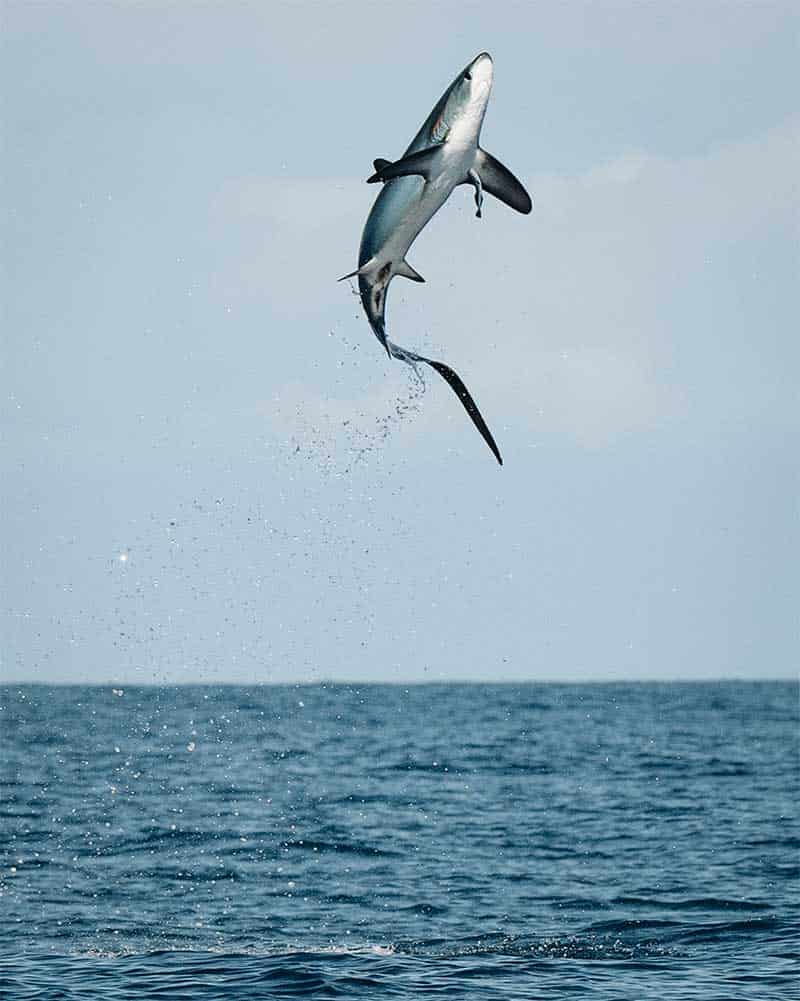
Scientific name: Alopias vulpinus
Type of shark: Mackerel sharks
Group/Order: Lamniformes
We can find Thresher sharks in temperate and tropical oceans around the world. These sharks have an exceptionally long tail that can be as long as their entire body.
The thresher shark has a short head, a small mouth with a range of small to large teeth, and a cone-shaped nose.
The thresher shark has a relatively slender frame, recurved pectoral fins, and small dorsal fins. They come in coloration ranges of blueish, brownish, or purplish grey.
The thresher shark is a solitary creature and is highly migratory. When hunting, the thresher shark uses its tail to swat smaller fish before feeding on them. They also use their elongated tail to propel themselves while jumping fully out of the water.
Thresher sharks feed on fish like mackerel, bluefish, crustaceans, and sometimes seabirds.
These sharks are vulnerable to overfishing and are listed as vulnerable to extinction.
19. Port Jackson shark
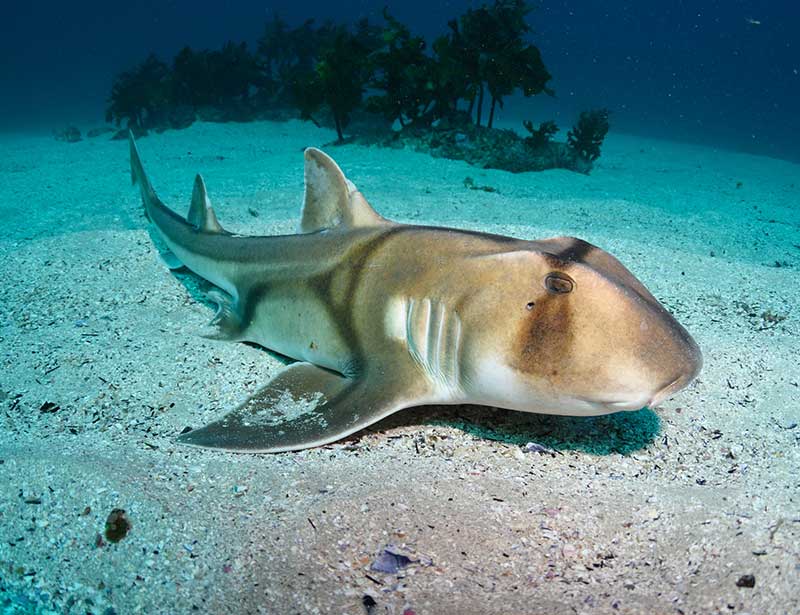
Scientific name: Heterodontus portusjacksoni
Type of shark: bull shark
Group/Order: Heterodontiformes
The Port Jackson shark is a nocturnal bottom-feeder found in the coastal waters off southern Australia, which means they are most active at night. These types of sharks can grow as long as 5.5 feet. They have a blunt, broad flat head, crests above their eyes, and an anal fin. They have harness markings that run from their eyes across their entire body.
Unlike other sharks, bull sharks lay eggs in a large egg case. You can find these types of sharks resting in caves in groups.
Port Jackson sharks are not a common food supply and have little to no importance to humans.
20. Sand Devil
Scientific name: Squatina dumeril
Type of shark: Angel shark
Group/Order: Squatiniformes
Found on the Atlantic coastline of North America, the Sand Devil shark is a species of the angel shark group. These sharks have flat bodies and live mainly at the bottom of the sea.
These types of sharks are as long as around 4.9 feet in length with a dark brown, greyish color. They have large round heads with barbels on their nostrils. Sand Devils feed on crustaceans and small bottom-dwelling fish.
Like other angel sharks, Sand Devils ambush their prey, snatching them quickly and effectively.
Typically, Sand Devils do not attack humans. However, these creatures can attack with their sharp teeth if provoked.
Conclusion
All kinds of sharks are apex predators that help maintain ocean health and ensure species diversity. They also reduce and recycle carbon by feeding on dead prey lying at the bottom of the ocean. Researchers are still discovering more shark species worldwide, and just like all of our world’s precious creatures, they deserve protection from human interventions and climate change.
| 1 | Gallagher, A.J., Klimley, A.P. The biology and conservation status of the large hammerhead shark complex: the great, scalloped, and smooth hammerheads. Rev Fish Biol Fisheries 28, 777–794 (2018). https://doi.org/10.1007/s11160-018-9530-5 |
| 2 | MATTHEWS, L.H. and PARKER, H.W. (1950), Notes on the anatomy and biology of the Basking Shark (Cetorhinus maximus (Gunner)).. Proceedings of the Zoological Society of London, 120: 535-576. https://doi.org/10.1111/j.1096-3642.1950.tb00663.x |
| 3 | Henderson, A.C., Flannery, K. and Dunne, J. (2001), Observations on the biology and ecology of the blue shark in the North-east Atlantic. Journal of Fish Biology, 58: 1347-1358. https://doi.org/10.1111/j.1095-8649.2001.tb02291.x |
| 4 | Colman, J.G. (1997), A review of the biology and ecology of the whale shark. Journal of Fish Biology, 51: 1219-1234. https://doi.org/10.1111/j.1095-8649.1997.tb01138.x |
| 5 | Holland KN, Anderson JM, Coffey DM, Holmes BJ, Meyer CG and Royer MA (2019) A Perspective on Future Tiger Shark Research. Front. Mar. Sci. 6:37. doi: 10.3389/fmars.2019.00037 |
| 6 | Size of the Great White Shark (Carcharodon), JOHN E. RANDALL, SCIENCE, 13 Jul 1973 |
| 7 | The Ocean Portal Team (reviewed by David Shiffman) (April 2018) Sharks and Rays, Smithsonian |
Jen’s a passionate environmentalist and sustainability expert. With a science degree from Babcock University Jen loves applying her research skills to craft editorial that connects with our global changemaker and readership audiences centered around topics including zero waste, sustainability, climate change, and biodiversity.
Elsewhere Jen’s interests include the role that future technology and data have in helping us solve some of the planet’s biggest challenges.

